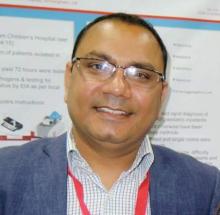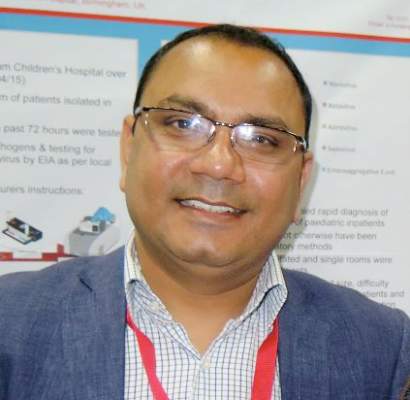User login
SAN DIEGO – Using a multiplex gastrointestinal PCR test known as the GI FilmArray enabled clinicians to rapidly diagnose infective diarrhea at a children’s hospital, allowing them to free up single rooms for patients presenting with other conditions.
“We have shown that this test can be used for infection control purposes,” Dr. Mitul Patel, a consultant microbiologist at Birmingham (England) Children’s Hospital, said in an interview at the annual Interscience Conference on Antimicrobial Agents and Chemotherapy. “People may want to look at this test not just purely from a diagnostic point of view, but as an adjunct to their infection control efforts.”
Manufactured by BioFire Diagnostics, GI FilmArray is a qualitative multiplex gastrointestinal polymerase chain reaction (PCR) which can detect 22 common gastrointestinal pathogens in about 1 hour. Dr. Patel and his associates set out to determine whether diagnosis with the device would facilitate infection control management of pediatric inpatients with diarrhea. “We postulated that if this test is negative, then we have reasonably excluded a pathogenic cause for their diarrhea,” he said. “If the test is negative, then that patient can [safely] be taken out of the isolation and kept on a general ward. In that case, the room can now be used for other patients.”
During a 3-week period in early 2015, the researchers identified 22 patients with a median age of 2 years who were isolated in a single hospital room because of diarrhea. Stool samples obtained from these patients were tested with the GI FilmArray as well as with routine culture for enteric pathogens and testing for Clostridium difficile, rotavirus, and adenovirus by enzyme immunoassay (EIA). Of the 22 patients, 11% (50%) were negative. The GI FilmArray detected a range of pathogens in the remaining 11 patients, including five cases of norovirus, four cases of rotavirus, two cases of Astrovirus, two cases of Sapovirus, and one case of enteroaggregative Escherichia coli. (More than one pathogen was detected in three patients.)
On the other hand, routine culture was negative in all cases, while EIA detected two of the four rotavirus cases that were positive on the GI FilmArray. “By conventional culture and PCR tests, we would have detected only two patients,” Dr. Patel said. “There were nine more patients [for whom] we had an etiological agent known.”
As a result of using the GI FilmArray, two patients were moved out of a single room. “The remaining nine, in spite of having a negative test, still remained in isolation for other reasons,” he said. These included imminent discharge home, protective isolation, and clinician preference.
The researchers acknowledged limitations of the study, including its small sample size, difficulty obtaining stool samples from all symptomatic patients, and the inability of a negative result to fully exclude infection.
They reported having no financial disclosures.
SAN DIEGO – Using a multiplex gastrointestinal PCR test known as the GI FilmArray enabled clinicians to rapidly diagnose infective diarrhea at a children’s hospital, allowing them to free up single rooms for patients presenting with other conditions.
“We have shown that this test can be used for infection control purposes,” Dr. Mitul Patel, a consultant microbiologist at Birmingham (England) Children’s Hospital, said in an interview at the annual Interscience Conference on Antimicrobial Agents and Chemotherapy. “People may want to look at this test not just purely from a diagnostic point of view, but as an adjunct to their infection control efforts.”
Manufactured by BioFire Diagnostics, GI FilmArray is a qualitative multiplex gastrointestinal polymerase chain reaction (PCR) which can detect 22 common gastrointestinal pathogens in about 1 hour. Dr. Patel and his associates set out to determine whether diagnosis with the device would facilitate infection control management of pediatric inpatients with diarrhea. “We postulated that if this test is negative, then we have reasonably excluded a pathogenic cause for their diarrhea,” he said. “If the test is negative, then that patient can [safely] be taken out of the isolation and kept on a general ward. In that case, the room can now be used for other patients.”
During a 3-week period in early 2015, the researchers identified 22 patients with a median age of 2 years who were isolated in a single hospital room because of diarrhea. Stool samples obtained from these patients were tested with the GI FilmArray as well as with routine culture for enteric pathogens and testing for Clostridium difficile, rotavirus, and adenovirus by enzyme immunoassay (EIA). Of the 22 patients, 11% (50%) were negative. The GI FilmArray detected a range of pathogens in the remaining 11 patients, including five cases of norovirus, four cases of rotavirus, two cases of Astrovirus, two cases of Sapovirus, and one case of enteroaggregative Escherichia coli. (More than one pathogen was detected in three patients.)
On the other hand, routine culture was negative in all cases, while EIA detected two of the four rotavirus cases that were positive on the GI FilmArray. “By conventional culture and PCR tests, we would have detected only two patients,” Dr. Patel said. “There were nine more patients [for whom] we had an etiological agent known.”
As a result of using the GI FilmArray, two patients were moved out of a single room. “The remaining nine, in spite of having a negative test, still remained in isolation for other reasons,” he said. These included imminent discharge home, protective isolation, and clinician preference.
The researchers acknowledged limitations of the study, including its small sample size, difficulty obtaining stool samples from all symptomatic patients, and the inability of a negative result to fully exclude infection.
They reported having no financial disclosures.
SAN DIEGO – Using a multiplex gastrointestinal PCR test known as the GI FilmArray enabled clinicians to rapidly diagnose infective diarrhea at a children’s hospital, allowing them to free up single rooms for patients presenting with other conditions.
“We have shown that this test can be used for infection control purposes,” Dr. Mitul Patel, a consultant microbiologist at Birmingham (England) Children’s Hospital, said in an interview at the annual Interscience Conference on Antimicrobial Agents and Chemotherapy. “People may want to look at this test not just purely from a diagnostic point of view, but as an adjunct to their infection control efforts.”
Manufactured by BioFire Diagnostics, GI FilmArray is a qualitative multiplex gastrointestinal polymerase chain reaction (PCR) which can detect 22 common gastrointestinal pathogens in about 1 hour. Dr. Patel and his associates set out to determine whether diagnosis with the device would facilitate infection control management of pediatric inpatients with diarrhea. “We postulated that if this test is negative, then we have reasonably excluded a pathogenic cause for their diarrhea,” he said. “If the test is negative, then that patient can [safely] be taken out of the isolation and kept on a general ward. In that case, the room can now be used for other patients.”
During a 3-week period in early 2015, the researchers identified 22 patients with a median age of 2 years who were isolated in a single hospital room because of diarrhea. Stool samples obtained from these patients were tested with the GI FilmArray as well as with routine culture for enteric pathogens and testing for Clostridium difficile, rotavirus, and adenovirus by enzyme immunoassay (EIA). Of the 22 patients, 11% (50%) were negative. The GI FilmArray detected a range of pathogens in the remaining 11 patients, including five cases of norovirus, four cases of rotavirus, two cases of Astrovirus, two cases of Sapovirus, and one case of enteroaggregative Escherichia coli. (More than one pathogen was detected in three patients.)
On the other hand, routine culture was negative in all cases, while EIA detected two of the four rotavirus cases that were positive on the GI FilmArray. “By conventional culture and PCR tests, we would have detected only two patients,” Dr. Patel said. “There were nine more patients [for whom] we had an etiological agent known.”
As a result of using the GI FilmArray, two patients were moved out of a single room. “The remaining nine, in spite of having a negative test, still remained in isolation for other reasons,” he said. These included imminent discharge home, protective isolation, and clinician preference.
The researchers acknowledged limitations of the study, including its small sample size, difficulty obtaining stool samples from all symptomatic patients, and the inability of a negative result to fully exclude infection.
They reported having no financial disclosures.
AT ICAAC 2015
Key clinical point: GI FilmArray enabled rapid diagnosis of infective diarrhea at a children’s hospital.
Major finding: Of 22 patients tested with the GI FilmArray, 11 (50%) were negative for gastrointestinal pathogens. The majority of cases would not otherwise have been detected by routine laboratory methods.
Data source: A single-center study which set out to determine if use of the GI FilmArray could facilitate infection control management of affected pediatric inpatients.
Disclosures: The researchers reported having no financial disclosures.

